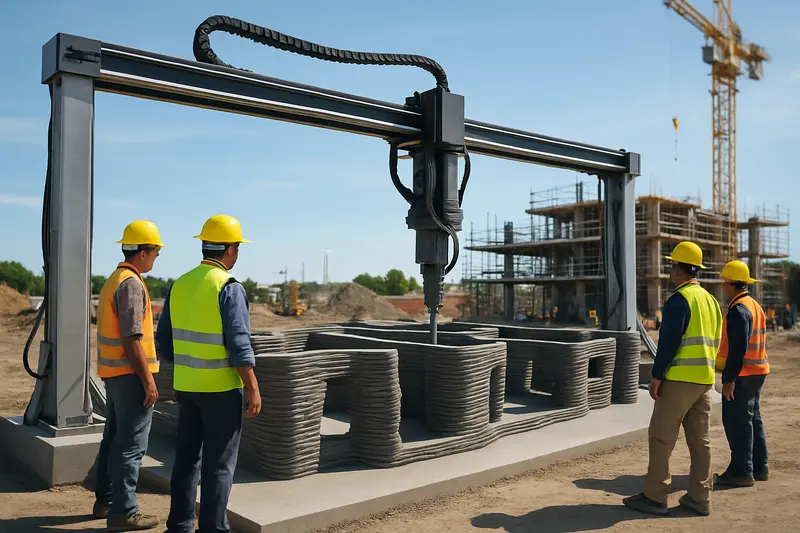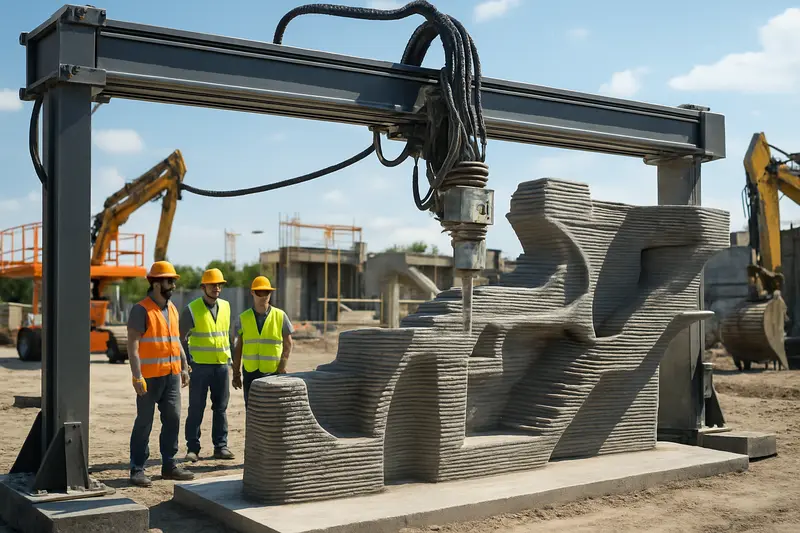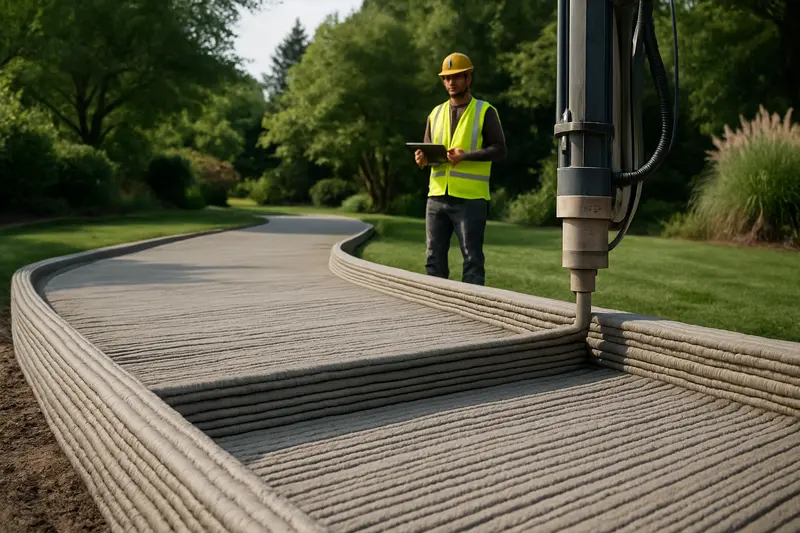
Revolutionizing Concrete Structures with 3D Printing Technology
3D printing technology is rapidly transforming concrete construction, allowing for faster, more precise, and innovative structures. In particular, concrete driveway contractors are leveraging these advancements to improve project timelines and quality. This evolution benefits concrete construction companies seeking efficient solutions for complex designs, reducing material waste, and minimizing labor costs. As 3D printing becomes more accessible, its integration into mainstream concrete projects signals a new era of construction that emphasizes speed, customization, and sustainability.
Advanced 3D Printing Applications in Concrete Construction

At a state-of-the-art construction site bathed in bright daylight, a massive 3D printer dominates the scene. This high-tech marvel extends several meters into the sky, with robotic arms meticulously depositing layers of fresh concrete with unparalleled precision. Fine streams of material flow steadily from nozzles, constructing intricate architectural forms and complex structural elements that would be arduous with traditional methods.
Workers clad in modern safety gear oversee the process, monitoring screens displaying real-time data on flow rates, layer thicknesses, and printer calibration. Their presence emphasizes the harmony between human expertise and technological innovation, ensuring each part of the structure aligns with the project’s exact specifications. The surrounding environment features advanced machinery—oscillating robotic arms, sleek hydraulic systems, and automated guidance modules—that coordinate seamlessly to facilitate the printing process.
The scene captures the essence of modern digital fabrication, where every detail is optimized for efficiency. The printer’s ability to build complex geometries without formwork reduces construction time substantially. Its adaptive technology automatically adjusts parameters to maintain uniformity, even when dealing with varying structural demands. This precision minimizes material waste, aligning with sustainability goals, while also allowing for customized designs tailored to aesthetic and functional needs.
A closer look reveals layered patterns within the freshly printed structure—each layer perfectly aligned, demonstrating the high resolution achievable through advanced printing techniques. The material appears dense yet workable, flowing smoothly from the nozzles, ensuring structural integrity. Integrated sensors constantly analyze environmental conditions like humidity and temperature, automatically adjusting parameters to guarantee optimal curing and strength.
This scene exemplifies the transformative potential of 3D printing in concrete construction, especially for large-scale applications such as driveways, walls, and custom architectural features. The ability to produce highly detailed, complex structures rapidly and accurately marks a significant shift from conventional methods. For driveway contractors and construction companies, adopting such technology means not only enhanced efficiency but also the capacity to deliver bespoke designs with a level of detail previously impossible.
The technological elements embedded in this scene showcase a future where construction becomes increasingly automated and precise. Projects can now be executed with fewer labor-intensive steps, reducing costs and timelines. Moreover, the flexibility of 3D printing enables contractors to meet bespoke client demands seamlessly, creating custom patterns or unique structural features without additional complexity.
In essence, the scene reflects a new paradigm in concrete construction—driven by innovation, driven by accuracy. As this technology continues to evolve, it promises to redefine construction standards, making structures more sustainable, resilient, and artistically versatile. For entities like concrete driveway contractors, embracing advanced 3D printing applications will be pivotal in staying competitive within this rapidly advancing industry. For more insights on how these tools are shaping the local landscape, visit this comprehensive guide on concrete contractor costs.
Benefits of 3D Printing for Concrete Driveway Contractors and Construction Efficiency

The process of creating a concrete driveway with advanced 3D printing technology exemplifies the remarkable benefits this innovation offers to contractors and construction companies alike. Imagine a bright outdoor setting where a state-of-the-art 3D printer steadily deposits layer upon layer of high-quality concrete, meticulously building a driveway with unparalleled precision. A skilled contractor closely monitors the operation, ensuring that each pass maintains accurate flow rates and structural integrity.
This layer-by-layer approach significantly enhances efficiency, reducing the need for extensive site preparation and formwork typically associated with traditional methods. The printer’s controlled flow of material ensures consistent thickness and surface smoothness, drastically minimizing human error. As a result, the driveway’s structural accuracy improves, leading to fewer repairs or adjustments post-installation.
Customization is another major advantage of 3D printing in concrete driveways. The digital design can be easily modified to incorporate intricate patterns, curves, or specific aesthetic features directly into the printing process. This flexibility enables contractors to offer clients personalized options that were previously labor-intensive or impossible to implement using conventional techniques.
Furthermore, the outdoor setting highlights the technology’s adaptability, as 3D printers can be operated with precision in various environmental conditions. The visible material flow—exhibiting the precise placement of concrete—demonstrates not only efficiency but also the potential for complex structural details such as textured surfaces, built-in drainage channels, or decorative inlays.
By automating much of the manual work, 3D printing reduces labor costs and shortens project timelines significantly. Tasks that would traditionally take days or weeks can now be accomplished in a fraction of the time, allowing companies to accept more projects and improve overall productivity. Additionally, this technological leap means fewer onsite waste materials, contributing to a more sustainable construction practice.
Contractors and construction firms should consider adopting 3D printing as a means to elevate their service offerings and stay competitive. As discussed in industry reviews, the integration of this technology is transforming how concrete structures are built, emphasizing not just speed but also craftsmanship and design innovation. For more insights into how this emerging tech is reshaping the construction landscape, you can visit this comprehensive guide.
Final words
The integration of 3D printing technology into concrete construction practices offers significant advantages for concrete driveway contractors and overall concrete companies. By enabling faster project completion, reducing waste, and unlocking design flexibility, this innovation addresses key industry demands. As the technology matures, expect increased adoption across diverse projects, pushing the boundaries of traditional concrete construction and setting new standards for quality and efficiency.
Find the Best Concrete Contractors in Houston
Learn more: https://concretecontractorshouston.com/contact/
About us
Join the Featured Listings on Concrete Contractors Houston and put your business in front of homeowners, builders, and businesses actively searching for concrete experts like you. As a Featured Contractor, your listing appears at the top of our directory—guaranteeing maximum visibility and making you the first choice in your service area.
